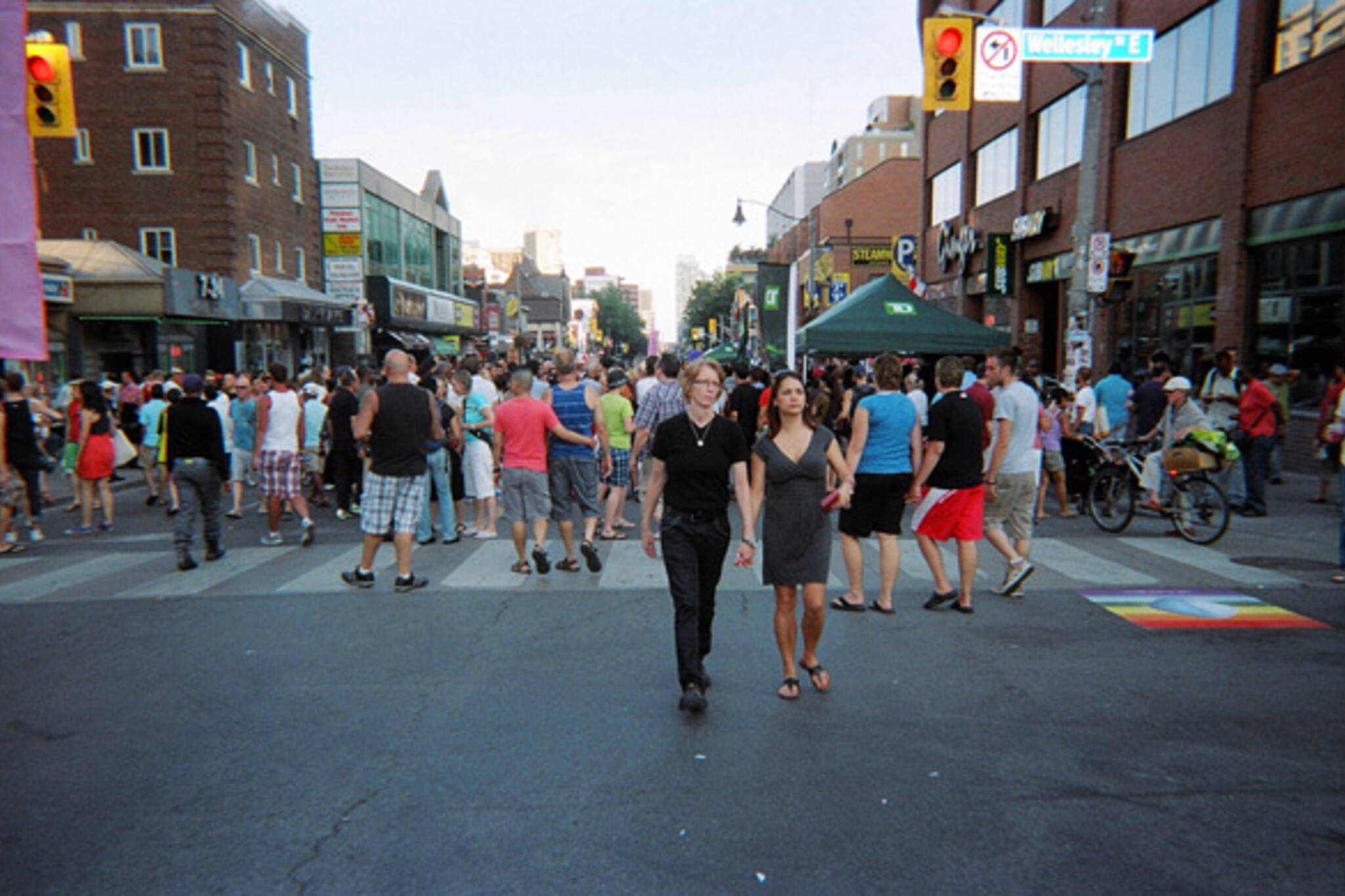
A brief history of the Church Wellesley Village
Toronto is celebrating Pride this week. The major events are centred in the Church Wellesley Village - with parts of Wellesley Avenue and Church Street closed down for a weekend street party. The Village - as the neighbourhood is nicknamed - is regarded as the heart of Toronto's LGBT community, but this has not always been the case.
In the early 1800s, prominent Scottish merchant and magistrate Alexander Wood purchased 25 acres of land at Yonge and Carlton streets that extended north to Wellesley and east to Church.
In 1810, Wood was involved in a scandal when it was discovered that he used his position of power to make sexual advances towards other men. While nothing was proven, Wood left town to escape the controversy and returned two years later. His land was mockingly called "Molly Wood's Bush"; molly being a derogatory term for homosexual.
Wood died in 1844 and his land was developed in the 1850s, including the opening of Alexander and Wood streets. In Spring 2005, a statue of Wood was established at Church and Alexander streets, to honour him as a forefather of Toronto's modern gay community.
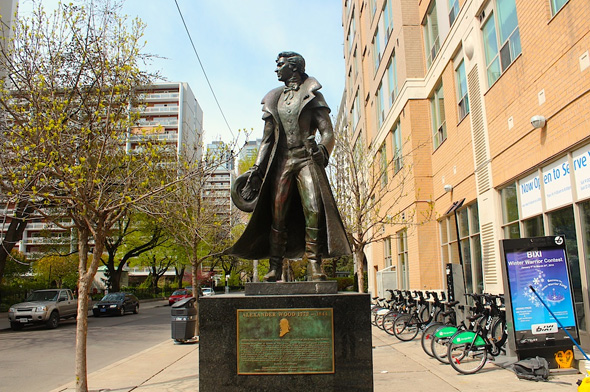
"It's important that we have a statue there to show that there's been a long history of queer people in the world," says Dennis Findlay, a longtime activist and volunteer at the Canadian Lesbian and Gay Archives.
The late 19th century saw Church-Jarvis-Sherbourne transformed into the city's chic neighbourhood; its prestige characterized by mansions and prominent residents like businessman Robert Simpson.
When the Depression hit in the 1920s, the Church and Wellesley community became a seedy rooming-house strip. It was not until the 1950s that gentrification lifted the neighbourhood back up. In 1954, Toronto's first high-rise apartments - City Park - were developed between Alexander and Wood streets.
"These spaces offered single people an opportunity to move away from family into affordable rental spaces downtown, offering them an opportunity to live their lives with more freedom. Many happened to be gay men and women," says Findlay.
In the early 60s, Toronto's gay subculture existed with some concentration along or near Yonge Street between Bloor and Carlton - with other locations around the city. During that time, most of the bars, dance clubs, and bathhouses were straight owned. In the 70s, the epicentre of the community shifted to Church, as businesses found more affordable spaces on this street. During this time, more businesses became gay owned.
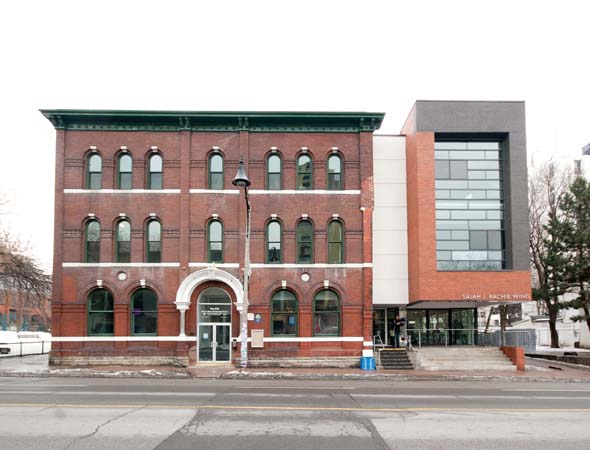
In 1975, the 519 Community Centre opened and marked the first time the City purchased a building for a community centre, after dedicated community members lobbied for the establishment of a meeting place. The original building was built in 1906 as an annex to the elite Granite Club. It also once housed the 48th Highlanders Legion Hall, which opened in May 1946.
Over the years, The 519 has provided a safe and welcoming space for a diverse range of community groups, of all backgrounds. Its programs have included: the first gay community program, Gay Youth Toronto; a social club for gay seniors; self defence classes; and a parenting program for LGBT individuals and couples interested in starting a family.
"(The 519) has been an essential community centre for a huge community, including the LGBT community - but a community of much diversity," says Findlay. "The community centre was very responsive to that community in all its diversity. It was a place where AAA meetings started happening, where Out groups started meeting and they were all made welcome."
On February 5, 1981, Toronto's gay community was rocked to its core after monumental raids on five downtown bathhouses. Police arrested over 300 gay men, charging them as keepers or found-ins of a common bawdy house. This incident became one of the largest Canadian mass arrest, second only to the 1970 FLQ crisis in Quebec. Bathhouse owners reported tens of thousands of dollars in damages.
The gay community erupted in anger, their reaction best described by a headline - "RAGE!" - in The Body Politic, one of Canada's first significant gay publication. The enraged community quickly mobilized and, overnight, organized a protest that drew 3,000 people who marched from Wellesley and Yonge to Dundas Street, over to 52 Police Division and eventually to Queen's Park.
"No More Shit" and "Fuck You 52" became the mantras of the furious and galvanized citizens. This event became Toronto's version of Stonewall, the landmark 1969 riots by New York City's gay community following a police raid.
"The significance of the bathhouse raids was that it was an attack on the (gay) community and humans rights to freedom," says Findlay, who was among the protestors and who later played a role in helping those affected by the raids.
"Within the queer community, all the differences that various groups had with one another disappeared the night of the raids. It brought the community together and politicized the community and individuals in a very significant way - such that when AIDS happened (in the years to come), we were organized and ready and we understood how to go about organizing around an issue."
In 1980, prominent gay activist George Hislop ran for - but lost - Toronto City Council; he was the first openly gay person to run for office in Toronto. Hislop situated his campaign office in Church and Wellesley. Following the bathhouse raids in 1981, Hislop, who co-owned one of the raided bathhouses, ran as an independent candidate in the provincial election to protest the raids. He also lost this election, but with a strong showing of 9% of the votes. Hislop passed away in 2005 and a park in the Village is named in his honour.
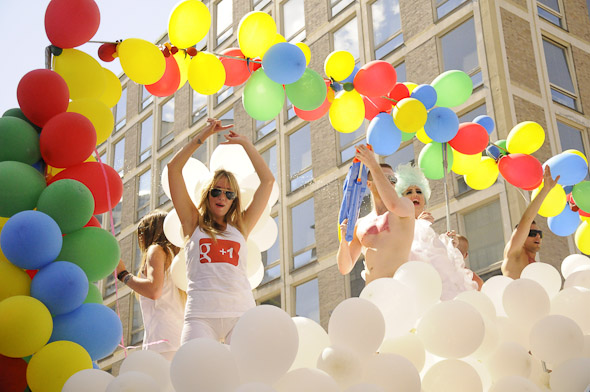
Following the raids, the Pride Toronto celebrations - founded in the 70s and established as an annual event in 1981 - were observed by a much larger and politicized community. According to Pride Toronto, 1984 saw a revival of Pride's political aspect with the theme: "We Are Everywhere: 150 Years of Faggots and Dykes." The festivities attracted 5,000 participants to Cawthra Park, on Church Street, north of Wellesley. For the first time, Church Street was closed and people danced in the street.
Every generation of the LGBT community had, has and will discover its own popular meeting spots within and beyond the Village. Findlay fondly remembers the earlier bars and dance palaces along Yonge Street, such as the St. Charles Tavern, the Parkside Tavern, Stages, the Quest, and Club Manatee.
One iconic hangout was The Second Cup, which opened south of Church and Wellesley in 1984. The "Steps" at the front of the cafe, which became a 24-hour operation in 1992, was a hangout for gay youth and people of all ages. It was not uncommon to find crowds congregating at the Steps in the early morning hours.
In 1993, Church Street entered pop culture consciousness, when The Kids In the Hall introduced The Steps to audiences around the world. Group members Mark McKinney and Scott Thompson had worked at the Second Cup in the late 80s. In recurring skits, characters on the show hung out on a studio recreation of the Steps, discussing topics such as gay marriage and AIDS.
"It was the focal point of the village," local business owner Dennis O'Connor told gay community paper Xtra! - founded on Church Street in 1984 - at the time of Cup's closure in 2005. At the time, O'Connor was chair of the Church Wellesley Village Business Improvement Area, established in 2002. "The Steps were an important point of what made the village what it is... It was a place to meet people... to talk about politics. It was a place to decide what needed to be done about this, that, and the other."
From 2000 to 2005, the Village would appear again in pop culture on the drama series Queer As Folk. The 83 episodes were shot in Toronto - including filming on Church Street and nearby gay establishments like Woody's and fly nightclub. This time, Toronto substituted for Pittsburgh; with Church Street playing the role of Liberty Avenue.
Today, the Village is still considered the heart of Toronto's LGBT community, but for the first time in a generation, its future relevance seems uncertain. Gay-friendly businesses are opening up in other parts of the city, such as Leslieville, Parkdale and Queen West. Condo developments, rising rents, and the arrival of bigbox store, like Loblaws, are taking a toll on businesses. At the same time, the once concentrated LGBT community is spreading out elsewhere across the city.
"Loblaws is sucking the life blood out of the businesses on the street," says Findlay. "What the community has to realize is that Church Street is still a commercial street, which provides essential services to people who live around it. One of the things they must realize is that in order to keep the amenities that are being provided by the grocery stores, clubs, bars, coffee shops, hardware store and other businesses, we have to have density - and enough people to support these businesses. If you don't have enough people to support going to Loblaws and to Pusateri's, one of those places is going to disappear."
Realizing the challenges and seizing an opportunity to revitalize the community, The 519, the Church Wellesley Village BIA and other organizations partnered to launch The Village Study earlier this Spring, inviting the community to have their say on what kind of neighbourhood Church and Wellesley can become in the coming decades.
With the study underway, the message the planning group has been hearing is that the community wants to preserve the Village as a queer destination.
Harold Madi, partner with The Planning Partnership, told Xtra! in May: "It's been a really inspiring process... What I hear the most from people is that need is still there. This area is still the place of arrival and transition for LGBT people across the country, especially those in smaller communities. They know Church and Wellesley. Gay youth and adults that are finding their identity, they come here..."
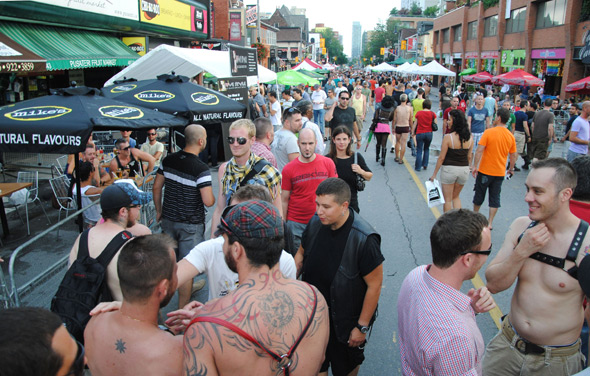
Alexander Wood statue from Franco Cignelli. Top photo from Randy Macdonald in the blogTO Flickr pool.
Latest Videos
Latest Videos
Join the conversation Load comments







